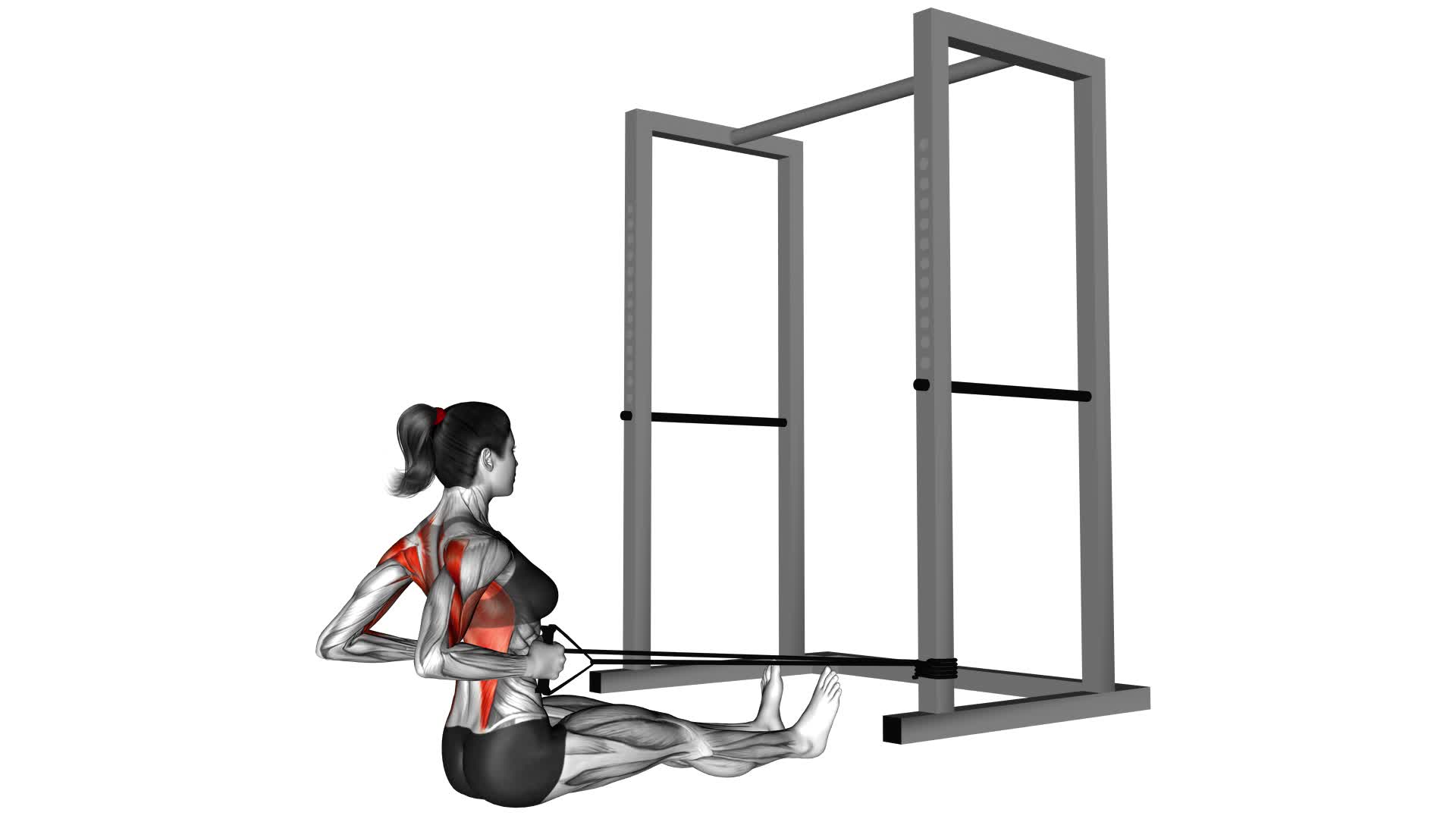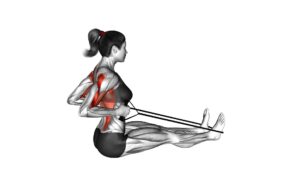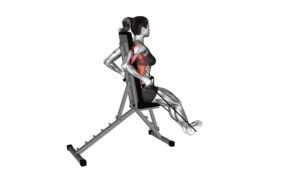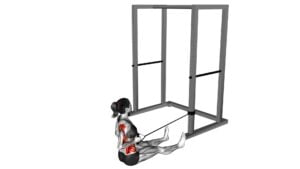Band Seated Row (Female) – Video Exercise Guide & Tips

Looking to strengthen your back muscles? The band seated row is a fantastic exercise for females that targets the upper back and shoulders.
Watch This Exercise Video
In this video exercise guide, we'll show you the proper form and technique to get the most out of this exercise. Avoid common mistakes and learn tips for increasing intensity and progression.
Incorporate the band seated row into your workout routine for a stronger, more defined back. Let's get started!
Key Takeaways
- Band Seated Row strengthens the upper back and shoulders, helping females to improve their overall upper body strength.
- By building lean muscle mass, this exercise contributes to a toned and sculpted physique for females.
- Band Seated Row helps to improve bone density, which is particularly beneficial for females who are at a higher risk for osteoporosis.
- This exercise boosts metabolism, aiding in weight loss and weight management for females.
Benefits of Band Seated Row for Females
Discover the benefits of the Band Seated Row for females.
Upper body exercises offer numerous benefits, and the Band Seated Row is no exception. Strength training is especially important for women, as it helps build lean muscle mass, improves bone density, and boosts metabolism.
One of the key benefits of the Band Seated Row is its ability to target multiple muscles in the upper body. This exercise primarily engages the back muscles, including the latissimus dorsi and rhomboids, which help improve posture and support the spine. It also activates the biceps, forearms, and shoulders, promoting overall upper body strength.
Furthermore, the Band Seated Row is a versatile exercise that can be modified to suit individual fitness levels. By adjusting the resistance of the band, you can gradually increase the challenge as you become stronger. This makes it an ideal exercise for women of all fitness levels, from beginners to advanced athletes.
Incorporating the Band Seated Row into your workout routine can lead to improved functional strength, enhanced athletic performance, and a toned upper body. So, ladies, don't underestimate the benefits of upper body exercises like the Band Seated Row. Start incorporating this exercise into your strength training regimen and reap the rewards it has to offer.
Equipment Needed for Band Seated Row
To perform a band seated row, you'll need a resistance band. There are various options available, ranging from light to heavy resistance, depending on your fitness level and goals.
It's important to ensure proper band attachment techniques to maximize the effectiveness and safety of the exercise.
Resistance Options Available
Resistance bands are a versatile and effective tool for strength training. Here are three options you can consider:
- Light resistance band: This option is great for beginners or those recovering from an injury. It provides less tension and allows you to focus on mastering the correct form and technique.
- Medium resistance band: As you progress, you can switch to a medium resistance band. This option offers more resistance, challenging your muscles and helping you build strength and endurance.
- Heavy resistance band: For advanced individuals looking for an intense workout, a heavy resistance band is the way to go. It provides maximum resistance, making each rep more challenging and promoting muscle growth.
Now that you know the resistance options available, let's move on to the next topic: proper band attachment techniques.
Proper Band Attachment Techniques
To properly attach the resistance bands for the Band Seated Row exercise, you'll need a sturdy anchor point and a secure attachment method. The band resistance is an excellent way to add intensity to your workout and target your back muscles effectively.
To begin, find a sturdy object or piece of equipment that can serve as an anchor point, such as a sturdy pole or heavy furniture. Next, loop the resistance band around the anchor point and secure it tightly. Make sure the band is at a level that allows you to comfortably perform the exercise.
If you don't have access to resistance bands, there are alternative exercises you can try, such as dumbbell rows or cable rows. These exercises will still target your back muscles and provide a challenging workout.
Proper Form and Technique for Band Seated Row
To perform the band seated row exercise with proper form and technique, it's important to focus on maintaining correct back posture and engaging your core. Keep your back straight and shoulders relaxed throughout the movement, avoiding any rounding or arching of the spine.
Engage your abdominal muscles to stabilize your body and prevent any excessive movement. By maintaining proper form and technique, you can maximize the effectiveness of the exercise and prevent injury.
Correct Back Posture
To maintain proper form and technique for the Band Seated Row exercise, ensure that your back posture is correct. Proper back posture is crucial to prevent back pain and maximize the effectiveness of strengthening exercises. Here are three key points to remember:
- Keep your back straight: Sit tall with your shoulders back and down. Avoid slouching or rounding your upper back, as this can strain your lower back and compromise your form.
- Engage your core: Activate your abdominal muscles by pulling your belly button towards your spine. This helps stabilize your spine and maintain a neutral position throughout the exercise.
- Avoid excessive arching: While it's important to maintain a natural curve in your lower back, be cautious of excessive arching. This can put excessive stress on your spine and lead to discomfort or injury.
By focusing on maintaining correct back posture, you'll optimize the benefits of the Band Seated Row exercise and minimize the risk of back pain.
Transitioning to the next section, let's now explore the importance of engaging the core.
Engaging the Core
To engage your core properly during the Band Seated Row exercise, ensure that you maintain a neutral position throughout and activate your abdominal muscles by pulling your belly button towards your spine. Engaging your core is crucial for core stability and maintaining proper body alignment during the exercise. By keeping your core tight, you create a stable base and prevent any excessive movement in your upper body. This allows you to focus on the targeted muscles in your back and avoid any strain or injury.
Remember to keep your back straight and shoulders relaxed as you perform the exercise. Engaging your core won't only improve your form but also maximize the effectiveness of the Band Seated Row.
Now, let's move on to the common mistakes to avoid.
Common Mistakes to Avoid
Avoid these three common mistakes when performing the Band Seated Row exercise:
- Using improper technique: One of the most common mistakes people make isn't maintaining proper form during the exercise. To avoid this, make sure to sit up straight with your chest lifted and shoulders back. Keep your back flat and engage your core throughout the movement. This will help to prevent straining your back and ensure that you're targeting the correct muscles.
- Using too much weight: Another mistake to avoid is using weights that are too heavy for you. It's important to start with a lighter resistance and gradually increase as you build strength. Using weights that are too heavy can lead to poor form and increase the risk of injury. Remember, it's better to start light and focus on proper technique than to lift heavy weights with improper form.
- Rushing the movement: Many people tend to rush through the Band Seated Row exercise, sacrificing proper form and control. Avoid this mistake by performing the movement slowly and with control. Focus on squeezing your shoulder blades together at the end of each repetition to really engage the muscles in your back. Taking your time won't only help you get better results, but also reduce the risk of injury.
Tips for Increasing Intensity and Progression
To increase the intensity and progression of the Band Seated Row exercise, try incorporating additional resistance bands or using a heavier weight.
Increasing resistance is key to challenging your muscles and promoting growth. By adding more resistance bands to your row, you can increase the difficulty of the exercise. This can be done by either using bands with higher tension or by using multiple bands at once.
Another option is to use a heavier weight. This can be achieved by using dumbbells or barbells instead of resistance bands. By using a heavier weight, you'll be pushing your muscles to work harder and adapt to the increased load.
Additionally, you can explore advanced variations of the Band Seated Row to further intensify your workout. These variations can include single-arm rows, alternating rows, or wide grip rows.
Remember to always maintain proper form and technique, and gradually increase the intensity and resistance to avoid injury.
With these tips, you can continue to challenge yourself and make progress in your fitness journey.
Incorporating Band Seated Row Into Your Workout Routine
Incorporate the Band Seated Row into your workout routine for an effective full-body exercise. This resistance training exercise offers numerous benefits, including increased muscle strength and endurance, improved posture, and enhanced back and core stability.
Here are three variations of seated row exercises that you can incorporate into your routine:
- Single-arm Band Seated Row: Attach a resistance band to a stable anchor point and sit on a bench facing the anchor. Grasp the band with one hand, keeping your arm extended. Pull the band towards your body, squeezing your shoulder blades together. Slowly return to the starting position and repeat on the other side.
- Wide-grip Band Seated Row: Sit on the bench with your feet securely placed on the resistance band. Grasp the band with a wide grip, palms facing down. Pull the band towards your lower chest, keeping your elbows close to your body. Slowly release back to the starting position and repeat.
- Underhand-grip Band Seated Row: Sit on the bench with your feet securely placed on the resistance band. Grasp the band with an underhand grip, palms facing up. Pull the band towards your lower chest, keeping your elbows close to your body. Slowly release back to the starting position and repeat.
Incorporating these variations of the seated row exercises into your routine will help you target different muscles and keep your workouts challenging and effective.
Frequently Asked Questions
How Many Repetitions Should I Aim for When Performing the Band Seated Row Exercise?
When performing the band seated row exercise, it's important to set a repetitions goal. This will help you track your progress and work towards improving your strength and endurance.
As a beginner, it's recommended to start with a lower number of repetitions, such as 8-10, and gradually increase as you become more comfortable and stronger.
Can the Band Seated Row Exercise Be Modified for Individuals With Lower Back Pain?
To modify the band seated row exercise for individuals with lower back pain, there are a few modifications you can try.
First, focus on maintaining a neutral spine position throughout the movement to reduce stress on the lower back.
You can also choose a lighter resistance band or adjust the height of the band attachment to lessen the load.
Lastly, consider using a bench with back support to provide additional stability and support for your lower back.
What Are Some Alternative Exercises That Can Be Incorporated Alongside the Band Seated Row for a Well-Rounded Back Workout?
Looking to switch up your back workout? Incorporating alternative exercises alongside the band seated row can give you a well-rounded routine.
Try exercises like bent over rows, lat pulldowns, and dumbbell rows to target different muscles in your back. These exercises will help you build strength and definition in your upper and lower back.
Don't be afraid to mix it up and find what works best for you and your fitness goals.
Is It Necessary to Warm up Before Performing the Band Seated Row Exercise?
Before performing the band seated row exercise, it's important for you to warm up. Warming up helps increase blood flow to your muscles and prepares them for the upcoming workout. It also helps reduce the risk of injury.
Additionally, it's crucial to maintain proper form during the band seated row exercise to target the muscles effectively and prevent strain. So, make sure to warm up and focus on your form to get the most out of this exercise.
Can the Band Seated Row Exercise Help Improve Posture in Females?
The band seated row exercise is a great way for females to improve their posture. By targeting the muscles in your back and shoulders, this exercise helps strengthen and align your spine, resulting in better posture.
The benefits of the band seated row extend beyond just aesthetics – proper posture can also reduce the risk of injuries and improve overall body mechanics.
Conclusion
The Band Seated Row is a highly effective exercise for females that targets the back muscles and improves upper body strength.
By using resistance bands, you can easily adjust the intensity to suit your fitness level.
Remember to maintain proper form and avoid common mistakes to maximize the benefits of this exercise.
Incorporate the Band Seated Row into your workout routine to achieve a stronger, more toned back.

Author
Years ago, the spark of my life’s passion ignited in my mind the moment I stepped into the local gym for the first time. The inaugural bead of perspiration, the initial endeavor, the very first surge of endorphins, and a sense of pride that washed over me post-workout marked the beginning of my deep-seated interest in strength sports, fitness, and sports nutrition. This very curiosity blossomed rapidly into a profound fascination, propelling me to earn a Master’s degree in Physical Education from the Academy of Physical Education in Krakow, followed by a Sports Manager diploma from the Jagiellonian University. My journey of growth led me to gain more specialized qualifications, such as being a certified personal trainer with a focus on sports dietetics, a lifeguard, and an instructor for wellness and corrective gymnastics. Theoretical knowledge paired seamlessly with practical experience, reinforcing my belief that the transformation of individuals under my guidance was also a reflection of my personal growth. This belief holds true even today. Each day, I strive to push the boundaries and explore new realms. These realms gently elevate me to greater heights. The unique combination of passion for my field and the continuous quest for growth fuels my drive to break new ground.



